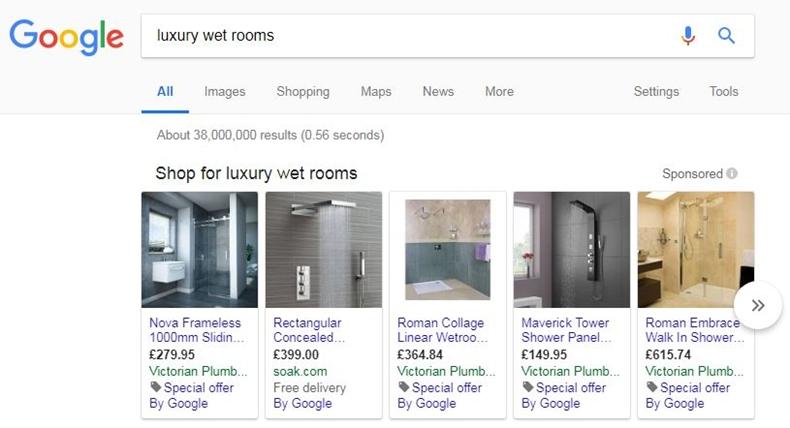We all know that our search engine optimization (SEO) efforts must adhere to some fundamentals. But that doesn't mean that SEO strategies are one-size-fits-all. In fact, one of the most challenging situations for B2B digital marketers is to have their business buried among search results that are B2C-focused.
The Problem
You have a business that specializes in providing a B2B product or service, but all of your keyword search terms return results that are B2C. The terms you want to rank for are also terms that e-commerce sites rank for; so, instead of your B2B service, Google Shopping widgets and online stores dominate the search results.
The result? High bounce rate, irrelevant traffic, and low conversion percentages.
This phenomenon is not uncommon across various industries, but it is prevalent in construction, where do-it-yourself (DIY) and professional design collide. For example: Your company designs and fits wet rooms for large commercial projects and new construction, such as hotels and high-rise apartment buildings; so, you want to target architects, developers, and consultants involved in big building projects... but many of your best keywords return results like this:
E-commerce search results can confuse B2B searchers, at which point one of two things will happen: (1) You lose website traffic because you're appearing so lower down the page than you otherwise would; (2) The traffic you get isn't the traffic you want, because they're B2C customers who will never convert.
So, how do you make your business attract the right kind of audience?
The Solution
The simple solution is to have a very specific strategy. The tricky part is its execution. You need to use your traffic effectively, position yourself correctly for search, create the right content, and make sure that you have relevant converting actions.
Let's take those one at a time.
Use your traffic effectively
Of course, not all traffic is good: You want the people who land on your service pages to be as likely to convert as possible. But, at the same time, getting lots of traffic from a variety of sources is an important ranking factor for Google. So how do we square this circle?
You don't want to reduce your traffic. Instead, divert it to the right places. Send your target audience to your service pages, and send the B2C traffic elsewhere.
Make your key converting pages target extremely specific, longtail keywords. Sure, the traffic may be miniscule, but because its hyper-specific you can rest assured that the few visitors you do get to the page will be much more likely to convert.
Using our example, the term "wet rooms for hotels" might get a couple of searches a month, but those one or two might be the property developers you're looking for who can drop a million pounds' worth of business at your door. Again, this is about quality of traffic over quantity.
Optimize your title tags and meta descriptions to communicate the right message to the right searcher to prevent wasted clickthroughs. The meta descriptions are you shop window, so you need to clearly explain your offering in order to manage the expectations of the searcher.
If your Google Local Business listing commonly appears next to e-commerce widgets like Google Shopping, make sure your listing is very specific and accurate with very clear messaging about your offering.
As for the rest of your B2C, nonconverting visitors, steer them toward content that they might find engaging. Doing so is most effective when answering query searches for B2C customers who are still in the information-gathering stage of their sales funnel.
Create a blog post to answer common questions in your industry that B2C searchers are asking. So, though a post targeting "can you fit a wet room on the second floor?" would likely not result in the conversion you're looking for, the amount of traffic it gets from B2C searchers adds authority to your site and sends positive ranking signals to Google.
And that will help support your overall SEO strategy, even if it doesn't appear to at first glance.
Create the right content
Like your title tags and meta descriptions, your on-site content needs to clearly communicate a B2B offering. Make sure your headings and titles clearly convey your messaging so your visitors know where they are and what they can expect.
Create content that your target audience will value. For B2B clients, that might be a downloadable brochure or case study. We know that B2B buying cycles have a much longer research and information-gathering period than B2C buying, so providing highly detailed information that can educate your audience is valuable.
For your off-site SEO strategy, focus on establishing relationships with industry publications and linking to your product pages in the content you create for them. That serves two important functions:
- A diverse backlink profile helps give your website authority in the eyes of Google (i.e., you will start to rank better).
- The traffic you'll get from such links is likely to be much more relevant than the traffic from organic search.
Encourage the right conversion actions
Keep your calls to action clear, and use language that is more effective for a B2B audience.
For example, rather than Buy Now, or a passive Contact Us, use powerful, service-focused CTAs:
- Get Started, Learn More, and Claim Your Free Trial are proactive CTAs direct in their message and they encourage urgency.
- Meanwhile, FREE 2 min demo, Our Work, and Download your FREE e-book are CTAs that tell the user exactly what they're getting.
Calls to action that encourage people to further explore your offering, such as a video or a case study, allow you to demonstrate the nature of your business offering.
Mastering Your B2B Search Marketing
B2B SEO is a challenging element of digital marketing, even more so when you have to position yourself so severely out of the B2C space. But that's no reason to be disheartened.
High bounce rates and irrelevant traffic are going to be inevitable, but you have to roll with the punches, and to wear down the negatives you have to try tactics such as those outlined in this article.
B2B search marketing is all about understanding the nuances of your end customer and where to ideally place your brand in order to convert that customer. Be proactive, target very specific niches, and make every visit from your target audience count.





